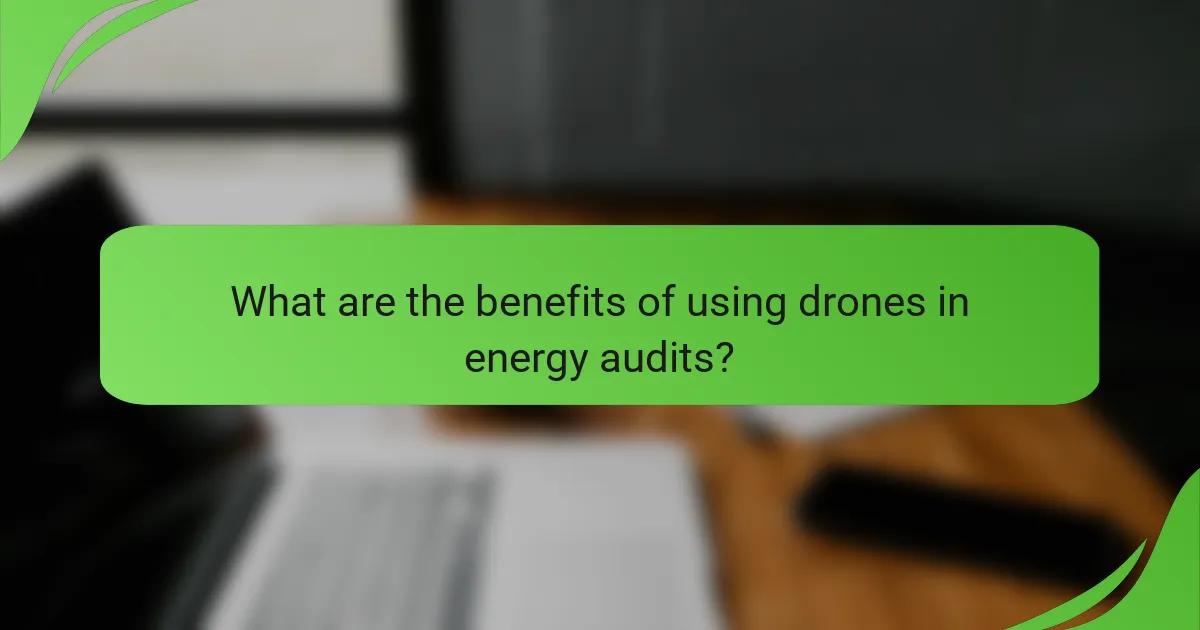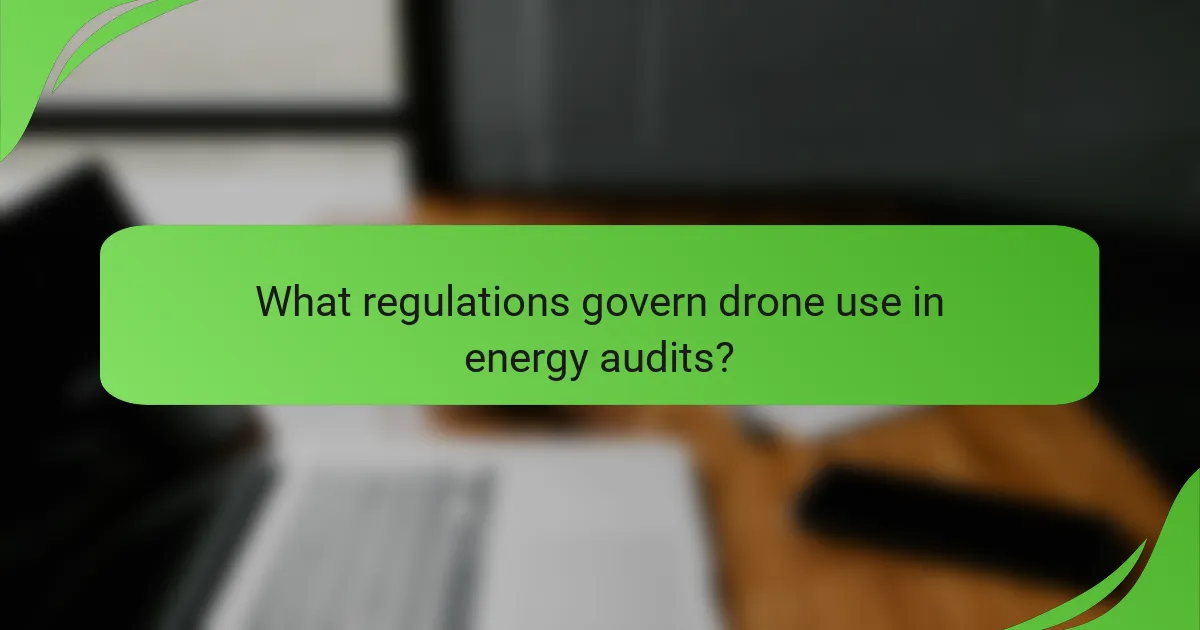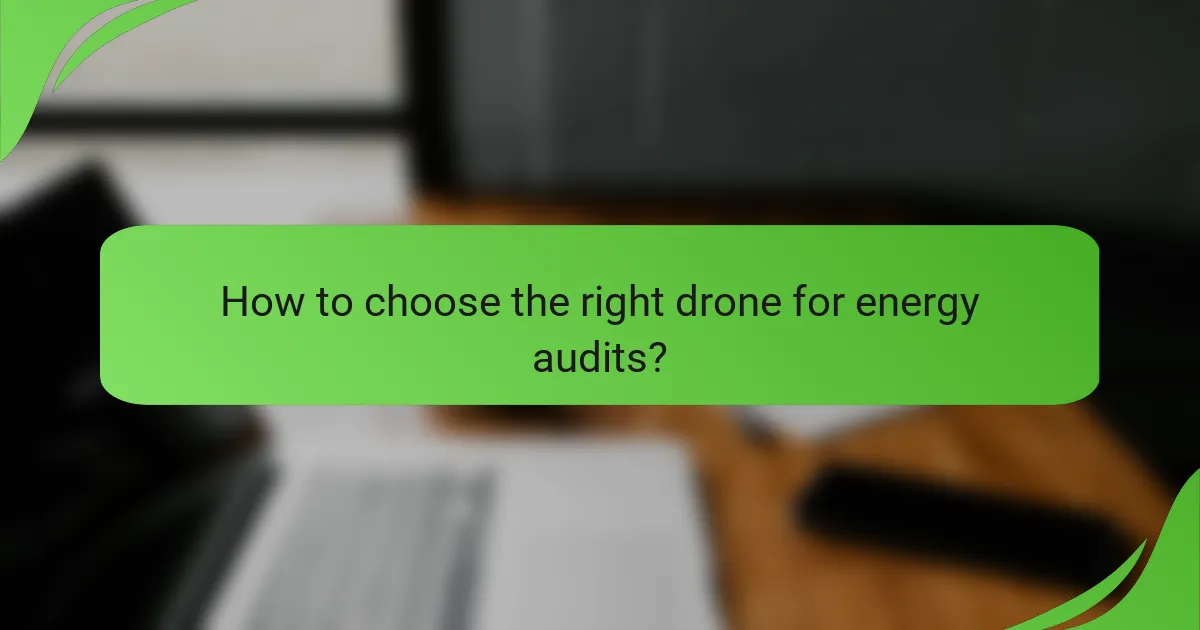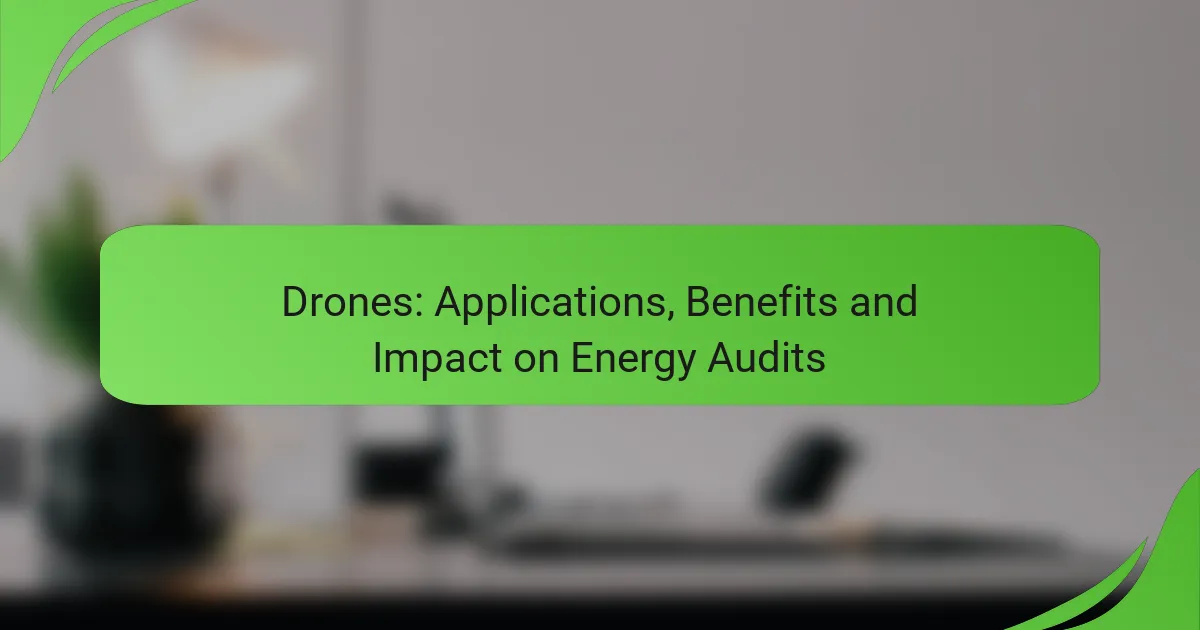Drones are revolutionizing the field of energy audits by improving efficiency and accuracy in data collection. Their ability to access hard-to-reach areas and provide high-resolution imagery allows auditors to conduct thorough assessments while minimizing safety risks and costs. As a result, the integration of drone technology streamlines the audit process and enhances overall energy performance evaluations.

How are drones used in energy audits?
Drones are increasingly utilized in energy audits to enhance efficiency and accuracy. They provide a cost-effective means to gather data and perform inspections, particularly in hard-to-reach areas, thereby streamlining the audit process.
Remote site inspections
Drones facilitate remote site inspections by capturing high-resolution images and videos of buildings and infrastructure. This capability allows auditors to assess conditions without the need for scaffolding or ladders, reducing both time and safety risks.
For instance, a drone can quickly survey a large commercial roof, identifying potential issues such as leaks or structural damage. This method is particularly beneficial in urban areas where access can be challenging.
Thermal imaging analysis
Thermal imaging drones are equipped with specialized cameras that detect heat variations, making them ideal for identifying energy inefficiencies. These drones can reveal areas where insulation is lacking or where heat is escaping, providing critical data for energy audits.
Using thermal imaging, auditors can pinpoint specific locations that require attention, such as poorly insulated walls or malfunctioning HVAC systems. This targeted approach helps prioritize repairs and improvements, leading to better energy performance.
Data collection for efficiency assessments
Drones collect extensive data during energy audits, which can be analyzed to assess overall efficiency. They can measure parameters like solar panel output, roof conditions, and vegetation impacts on energy consumption.
Auditors can use this data to create detailed reports that highlight energy-saving opportunities. For example, by analyzing shading patterns from nearby trees, auditors can recommend optimal solar panel placements to maximize energy generation.

What are the benefits of using drones in energy audits?
Drones offer significant advantages in energy audits, including enhanced efficiency, cost-effectiveness, and improved safety. By utilizing aerial technology, energy auditors can quickly gather data and assess energy performance without the need for extensive manual inspections.
Cost savings
Using drones in energy audits can lead to substantial cost savings. Traditional audits often require extensive manpower and time, which can increase labor costs significantly. Drones reduce the need for scaffolding or ladders, minimizing equipment expenses and labor hours.
For example, a drone can complete an inspection of a large facility in a fraction of the time it would take a team on the ground, potentially reducing audit costs by 30-50%. This efficiency allows companies to allocate resources more effectively, enhancing overall productivity.
Increased safety
Drones enhance safety during energy audits by minimizing the need for personnel to work at heights or in hazardous environments. This reduces the risk of accidents and injuries associated with traditional inspection methods.
For instance, drones can easily access rooftops or hard-to-reach areas without putting workers at risk. This is particularly important in industries with strict safety regulations, where compliance can be costly and complex.
Faster data acquisition
Drones enable faster data acquisition during energy audits, allowing for real-time analysis and quicker decision-making. Equipped with high-resolution cameras and thermal imaging technology, drones can capture detailed images and data in minutes.
This rapid data collection streamlines the audit process, enabling auditors to identify energy inefficiencies and recommend improvements almost immediately. In many cases, what once took days can now be accomplished in a few hours, significantly speeding up project timelines.

How do drones improve accuracy in energy audits?
Drones enhance accuracy in energy audits by providing detailed aerial views and precise data collection capabilities. Their ability to capture high-resolution images and process data in real-time allows for more thorough assessments of energy efficiency in buildings and infrastructure.
High-resolution imaging
Drones equipped with high-resolution cameras can capture detailed images of building exteriors, roofs, and solar panels. This imaging capability allows auditors to identify issues such as heat loss, insulation problems, and equipment malfunctions that may not be visible from the ground.
For instance, thermal imaging drones can detect temperature variations, helping to pinpoint areas where energy is being wasted. This level of detail can lead to more accurate energy assessments and targeted recommendations for improvements.
Real-time data processing
Real-time data processing enables drones to analyze information as it is collected, providing immediate insights into energy performance. This capability allows energy auditors to make quick decisions and adjustments during the audit process, improving overall efficiency.
By using software that integrates with drone data, auditors can generate reports on energy usage and efficiency on-site, reducing the time between data collection and analysis. This immediacy can lead to faster implementation of energy-saving measures, ultimately benefiting both the environment and the bottom line.

What are the key features of drones for energy audits?
Drones used for energy audits are equipped with advanced technologies that enhance their efficiency and accuracy. Key features include GPS capabilities for precise location tracking and various payload options for sensors that measure energy efficiency and detect issues.
GPS capabilities
GPS capabilities are crucial for drones conducting energy audits as they allow for accurate mapping and navigation. This precision enables auditors to pinpoint specific areas of interest, such as solar panels or building facades, ensuring thorough inspections.
When selecting a drone, consider models with high-accuracy GPS systems that provide real-time location data. This feature is especially important in large facilities or expansive solar farms, where precise positioning can significantly impact the audit’s effectiveness.
Payload options for sensors
Drones can be equipped with a variety of sensors tailored for energy audits, including thermal imaging cameras, LiDAR systems, and multi-spectral sensors. These payload options enable the detection of heat loss, structural issues, and energy inefficiencies.
Choosing the right sensor depends on the specific goals of the audit. For example, thermal cameras are ideal for identifying insulation problems, while LiDAR can create detailed 3D models of structures. Ensure that the drone’s payload capacity aligns with the sensors’ weight and power requirements to avoid performance issues.

What regulations govern drone use in energy audits?
Drone use in energy audits is primarily regulated by aviation authorities and local laws, which ensure safety and compliance during operations. Understanding these regulations is crucial for companies looking to integrate drones into their energy audit processes.
FAA regulations in the United States
The Federal Aviation Administration (FAA) governs drone operations in the U.S., requiring operators to follow specific rules. For commercial use, including energy audits, operators must obtain a Part 107 certification, which mandates passing an exam and adhering to operational guidelines.
Key FAA regulations include maintaining visual line of sight, flying below 400 feet, and not operating near airports without prior authorization. These rules help ensure safety and minimize risks during energy audits conducted with drones.
Local compliance requirements
In addition to FAA regulations, local compliance requirements may vary significantly by state or municipality. Some areas may have additional restrictions on drone flights, such as no-fly zones or specific permits for commercial use.
It is essential to check local laws before conducting energy audits with drones. This may involve contacting local aviation authorities or reviewing municipal regulations to ensure full compliance and avoid potential fines or operational disruptions.

How to choose the right drone for energy audits?
Choosing the right drone for energy audits involves considering specific features that align with your audit requirements. Key factors include payload capacity, flight time, and the types of sensors needed for effective data collection.
Consider payload capacity
Payload capacity refers to the maximum weight a drone can carry, which is crucial for energy audits that may require specialized equipment. Drones typically have payload capacities ranging from a few hundred grams to several kilograms, depending on the model.
For energy audits, ensure the drone can support thermal cameras or other sensors without exceeding its weight limit. A common pitfall is underestimating the weight of additional equipment, which can affect flight performance and data accuracy.
Evaluate flight time
Flight time is the duration a drone can operate before needing a recharge or battery swap. Most drones suitable for energy audits offer flight times between 20 to 40 minutes, but this can vary based on payload and environmental conditions.
When selecting a drone, consider how long you need to conduct your audits without interruptions. Longer flight times reduce the need for frequent battery changes, allowing for more efficient data collection. Always check the manufacturer’s specifications and consider investing in extra batteries for extended operations.
